Test – Sapphire R9 280X VaporX Tri-X: Review| Specs| Test| Hashrate |Price On Amazon| Pros & Cons| CPU Performance| Config | Advantage (Pros) and Disadvantages (Cons) and other important features that will help you make better decision.
We continue the tests of the R9 280X from AMD with today a model that is out of the ordinary whether it is at the level of the PCB which is modified by these gentlemen from Sapphire and at the level of the cooling system which is, and not let’s not mince words just huge, I named the Sapphire R9 280X VaporX Tri-X! As its name suggests, it is equipped with the brand’s famous VaporX cooling system with 3 fans, because 1 or 2 is not enough! Today’s test model is not the overclocked version so the card runs at 1000 MHz for the GPU and 1500 MHz for memory.
However the price does not really explode and it can be found at a price of around 220 € which is really not excessive, let’s see what the beast has in the belly!
Characteristics

Specification: Hashrate – Sapphire R9 280X VaporX Tri-X
| Sapphire R9 280X VaporX Tri-X | |
|---|---|
| GPU | Tahiti |
| GPU frequency | 950MHz 1000 Mhz Boost |
| Memory Frequency | 1500 Mhz |
| Amount of memory | 3 Go de DDR5 |
| Memory bus | 384 bit |
| Connectivity | 1 x HDMI 1 x DisplayPort 1.2 1 x Dual-Link DVI-D 1 x Dual-Link DVI-I |
| Dimensions | 30.8 x 10.8 x 3.5 cm |
| Food | 2 x 8-pin |
| Price | ~ 220€ |
| Guarantee | 2 years |
As we can see the characteristics of the Sapphire R9 280X VaporX Tri-X do not really change from the other cards, the big difference is mainly made in the dimensions with a rather impressive length of almost 31cm, beware of the space available in the housing! The presence of 2 8-pin connectors for the power supply shows that the card has had a special treatment compared to the majority of other R9 280X on the market which have 1 x 6-pin and 1 x 8-pin. Connectivity side we stay in the classic with 2 x DVI 1 x HDMI and 1 x mini display port, enough to connect a good little bunch of screens.
Offered at around € 220, the price is contained and should be a plus if the card proves to be silent under load, we will see all of this during the tests!
Box and Bundle
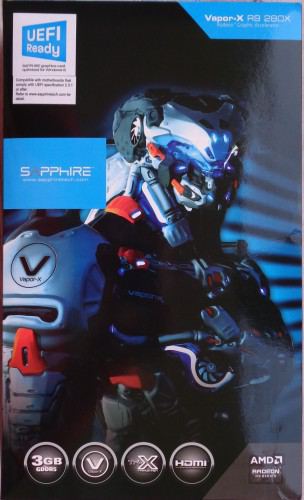
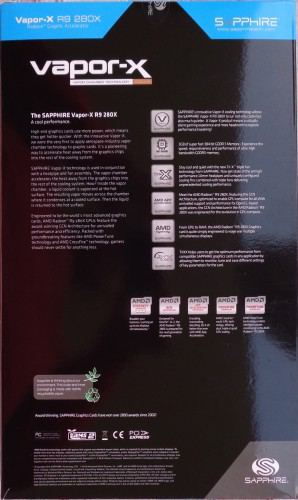
The box of the Sapphire is no exception to the usual boxes of the manufacturer, we find a mixture of blue and black, on the front face a robot with the threatening air which has absolutely nothing to do with the graphics card in it- same but immediately announces that it will heat up! In addition to this robot we see that the card is “UEFI Ready”, that there is 3GB of memory, the VaporX Tri-X cooling system as well as the presence of an HDMI connector (still happy!).
At the back a list of the main strengths of the card is available, VaporX, Tri-X, 3GB of memory, AMD APP, Sapphire TriXX etc.
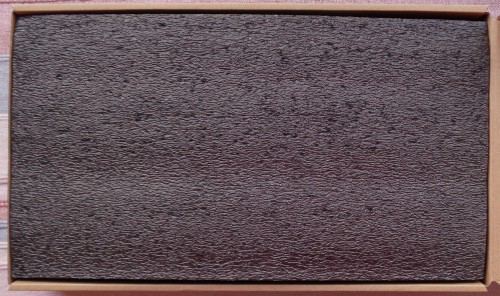
Inside the box when opening we fall on a thickness of foam keeping everything well protected.
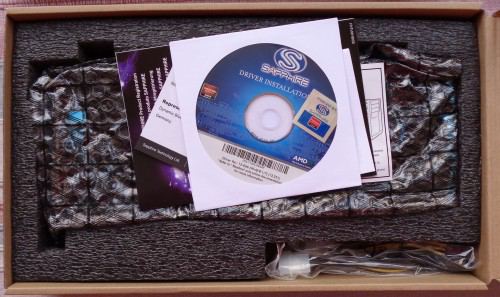
Under this thickness of foam we fall directly on the CD of drivers and manuals.

As we can see the graphics card itself is very well protected, in a bubble bag itself caught in thick foam, transport should not be a problem for our “little” Sapphire R9 280X VapoX Tri-X!

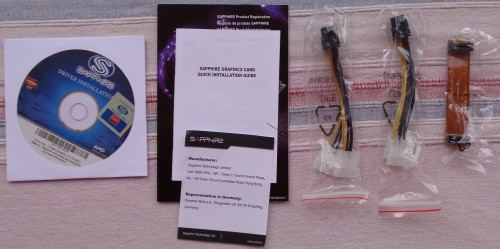
The bundle consists of:
- 1 x Sapphire R9 280X VaporX Tri-X
- 1 x CD de drivers
- 2 x adaptateurs 2 x molex -> 1 x PCIe 8-pin
- 1 pont Crossfire
- The different guides
As we can see the bundle is quite honest, without being extravagant, apart from the eternal CD of drivers there are 2 very practical adapters in case the power supply does not have 2 PCIe 8-pin ports , as well as the Crossfire adapter in the case of multi-card use.
The map
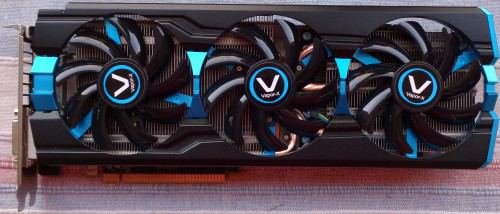
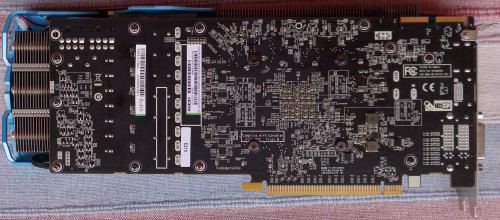
Here is the beast! The first thing that strikes you when you see the thing is its size! Indeed we quickly realize that 31 cm for a graphics card is big, very big! In addition to its disproportionate length there are 3 fans which will certainly know how to cool the card very well. In terms of colors we remain in the standard at Sapphire with a mixture of blue and black of the most beautiful effect. The build quality is really excellent, the card is heavy and does not bend in any way when handling.
At the back we find a black PCB equipped, we see that there are a lot of screws that are attached to it which will greatly improve the rigidity of the card, and it’s really not a bad thing! A small touch of tuning is however on this sober PCB, the presence of 6 LEDs which represent the use of VRMs, the more the card is loaded and the more the LEDs light up, see instead:


On the first photo a very moderate load on the desktop, the second represents a load under OCCT, we can see that the VRMs are clearly not loaded in the same way! However the usefulness of the thing is very limited, but you can see at a glance if the graphics card is working or not 😉


The cooler is covered with a metal fairing of very good quality, everything is well fixed and does not move a bit. We can also see that the cooler is equipped with a thick metal plate covering all the essential components, I will see this in detail below! Note that the log lights up when the power is turned on, like this:

Light fans of all kinds will love it, others won’t care!
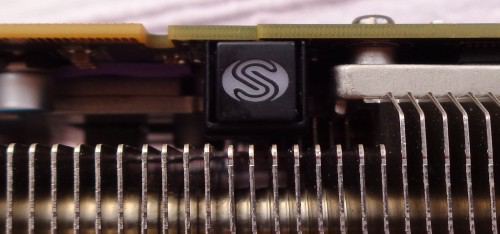
A button is present to manage the 2 bios present on the card, a “legacy” bios position and another “UEFI” bios for a faster start (subject to having the compatible motherboard!).
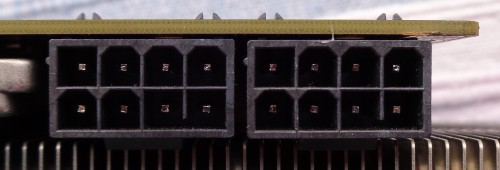
Just to have enough juice that arrives at the beast Sapphire has decided to install 2 8-pin connectors, for a total of 375 Watts maximum, which means that this will never be achieved with an R9 280X, unless you go out. liquid nitrogen.

A familiar sight here, 2 DVI ports, 1 HDMI port and 1 DisplayPort port. Some holes are also present for the ventilation of the card, even if in the end the air will be expelled inside the tower.
We undress the young lady
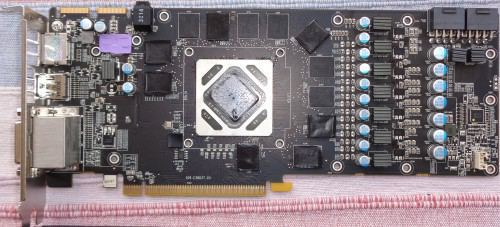
Here is the beast laid bare! As we can see via the thermal pads almost all of the components are in direct contact with the cooler, which promises optimal cooling, much better than some competing cards. The design here is not at all that of the original R9 280X, Sapphire has put a grain of salt here and there to lay a PCB of their own, so beware of water cooling enthusiasts who will certainly not find a suitable waterblock.
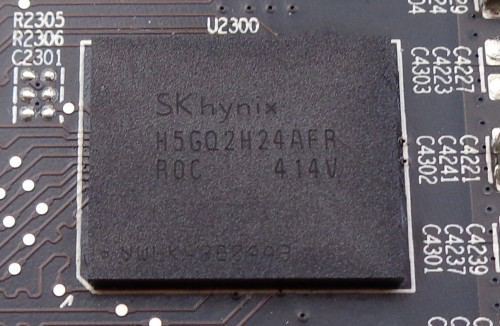
The memory is entrusted to Hynix with the famous H5GQ2H24FR R0C which are given to run at 1500Mhz, the same frequency as the test card. Memory which is also equipped on a large part of the R9 280X.
TriXx software
IPower software is mentioned several times on the box, but what is its use in the end? Well, it is the brand’s overclocking software, it allows you to see the card information, to manually adjust the ventilation system but also and above all to modify the frequencies and voltages of the card! Let’s see all this more ready.
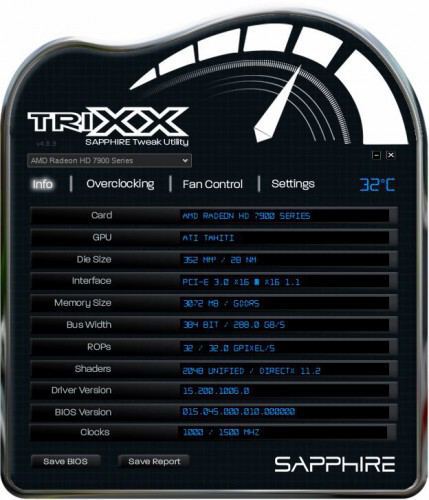
Here we can see all the information about the card like GPU, PCI-E interface, memory, driver version etc.
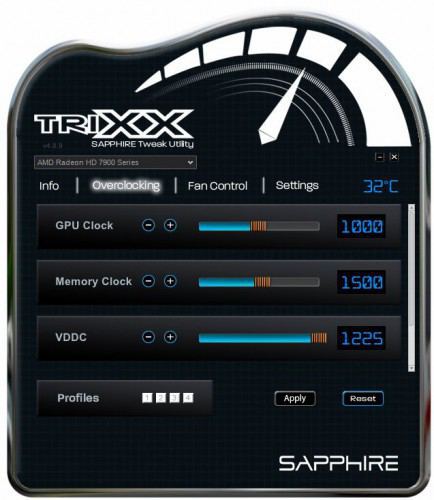
What interests us particularly, overclocking! On the Sapphire R9 280X VaporX Tri-X it will be possible to modify the GPU frequency as well as the memory, the voltage is already set to the maximum, and the consumption limit is not modified. Unfortunately for a thorough overclocking it will be necessary to go through other software.
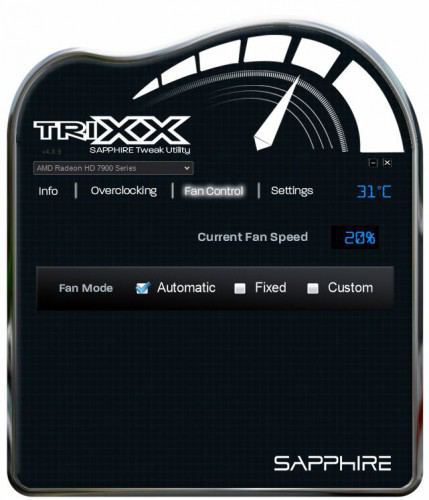
Here is a very interesting and very useful part, we can decide to let the card manage the fan, set it to a fixed value or to manually modify the ventilation curve manually. Thanks to this we can very well make a card as quiet as possible or have an aggressive ventilation (in the event of significant overclocking for example).
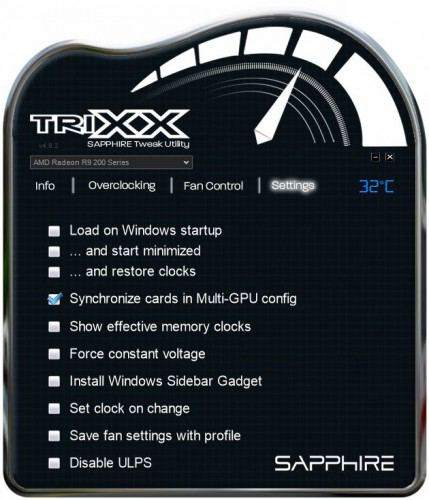
Software options, application of parameters at start-up, synchronization of multiple cards at the same settings, activation of VRM protection in the event of overheating, etc.
The test platform
The configuration used during the tests is as follows:
- Processeur: Intel Core i5 4670K @ 4 Ghz
- Motherboard : Gigabyte Z87-UD5H TH
- Mémoire: Kingston HyperX 4 x 2 Go 1600Mhz
- Disque dur: WD Raptor 150 Go
- Power supply : Seasonic X650
- Drivers: Catalyst 14.4 (AMD) & GeForce 337.88 (nVidia)
- Operating system : Windows 8.1 64bits
All games will be tested in 1920 × 1080 detail in full detail (except the TressFX on Tomb Raider), which is the current ‘standard’, graphics cards used in testing are as follows:
- Asus GTX770 DirectCU OC
- HIS R9 290 iPower IceQ X² OC 4GB (testée ici)
- MSI R9 280X Gaming (tested here)
- MSI R9 290 Gaming OC 4GB (tested here)
- Powercolor R9 280X (tested here)
- Sapphire 7950 Dualx @ 900Mhz
- Sapphire 7970 Ghz Edition
- XFX R9 280 Double Dissipation (tested here)
- XFX R9 285 Black Edition (tested here)
- XFX R9 290 Double Dissipation (tested here)
Consumption / Temperature

The consumption test was carried out under OCCT Power Supply which makes it possible to push the consumption of the components to the maximum, note that this value reflects the total consumption at the outlet of the machine and not the graphics card itself!
The Sapphire R9 280X VaporX Tri-X remains here completely in the nails with a consumption identical to the other 7970 Ghz Edition R9 280X with 369 Watts in load. Here we are far from urban legends saying that you need a power supply of at least 600 Watts to run a PC equipped with an R9 280X, a 450 Watts as long as it is of quality with enough power on the 12V will already be a very good starting point, especially with the output (80 Plus Gold in my case) the components themselves draw around 330 Watts on the power supply.
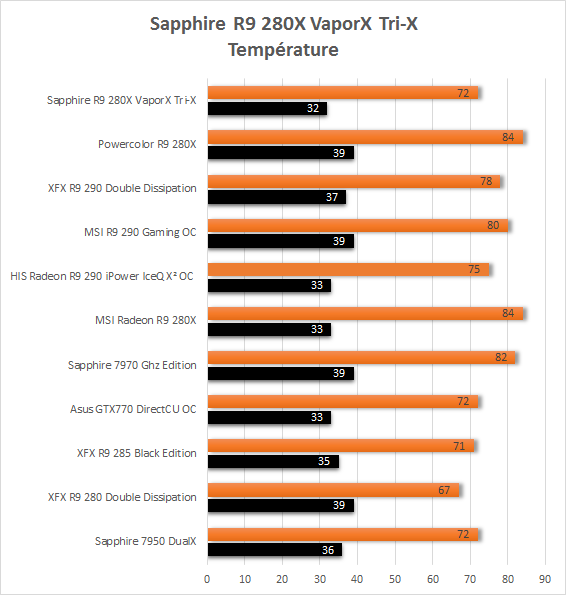
Sapphire with its VaporX Tri-X cooler signs here a very good result, the cooling system is clearly efficient and holds the R9 280X at 72 ° under OCCT, which is excellent.
Sound level
Warning: Part to be taken with a grain of salt, unfortunately not having access to the appropriate equipment and using an android application to take the readings The measurements below are only indicative! The readings were taken 20cm from the graphics card.
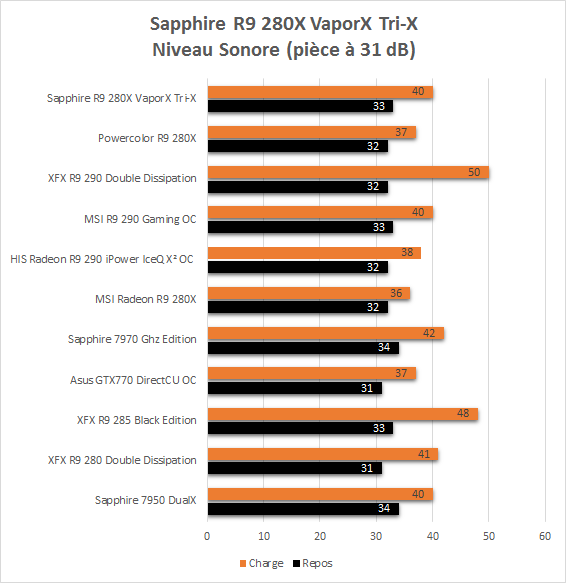
In terms of noise pollution the Sapphire R9 280X VaporX Tri-X holds up very well, indeed with 33 dB even if it is not inaudible it will clearly not be heard once in a box. Under load and with 40 dB the results are quite good, without being exceptional, once in a box the noise will most certainly be drowned in the noise generated by the other fans, it will be necessary to manage a personalized ventilation profile in order to further reduce the nuisance sound linked to the 3 fans.
Powertune
To get started, let’s take a look at the Powertune that powers the R9 280X. Powertune is responsible for maintaining the temperature of the processor, the consumption of the card below certain values. During overclocking it is mandatory to be able to modify all the possible settings in order to get the best performance, for Powertune and the R9 280X series it is possible to increase the consumption limit of the card by 20% (50% for the R9 290 / 290X).
Let’s see how the GPU reacts when subjected to OCCT:

Even without touching the consumption limit, the card from Sapphire does not flinch in the least, the 1000 MHz of the GPU remain stable throughout, a very good point therefore. With this there is almost no chance of in-game performance degrading due to Powertune purposely “restraining” the map.
3DMark Fire Strike

Battlefield 4

Bioshock Infinite
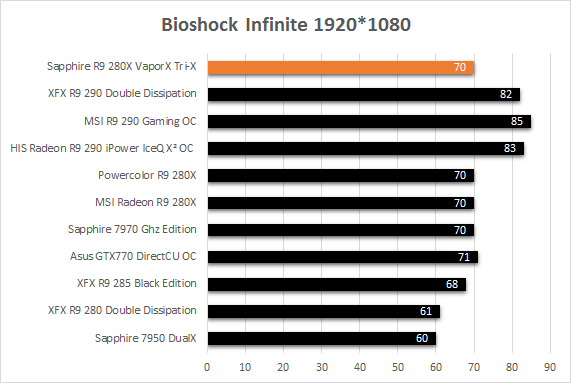
Crysis 3
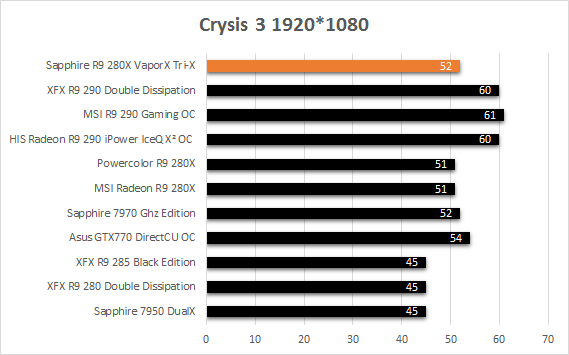
Hitman Absolution
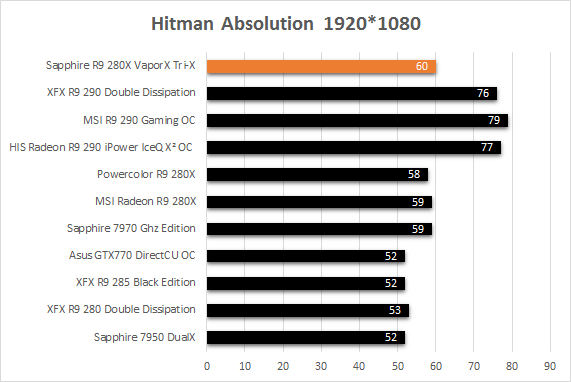
Tomb Raider
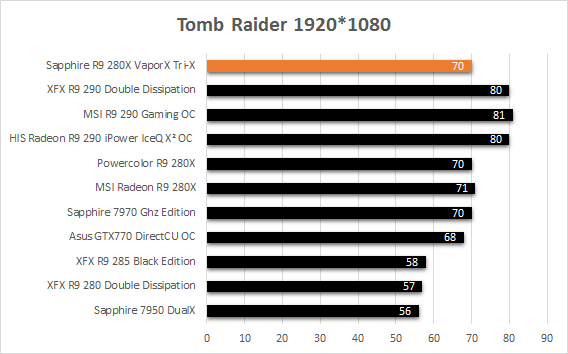
Summary of performance
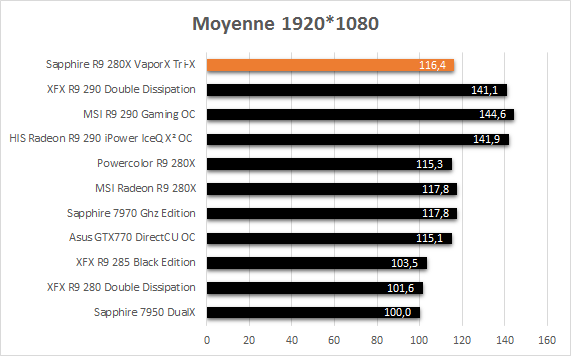
I imagine that there is not really a need for a big speech in view of these results, the Sapphire R9 280X Tri-X has identical performance to the other R9 280X in the comparison, no more and no less! What we can learn from all of this is that the AMD R9 280X GPU is quite capable of running games in excellent conditions at 1920 × 1080, although the R9 290s are still far more capable.
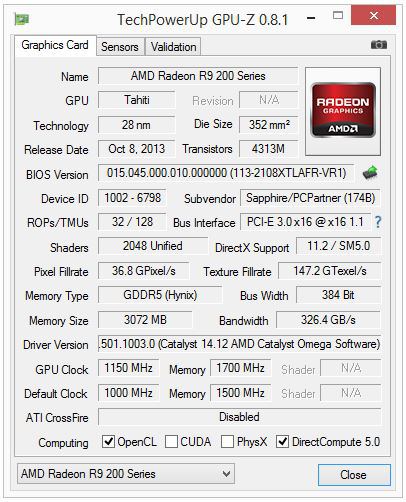
The maximum overclocking achieved, with the help of the 20% additional consumption is:
- GPU: 1150 Mhz (+150 Mhz)
- Memory : 1700 Mhz (+ 200 Mhz)
The Sapphire R9 280X VaporX Tri-X was very docile in overclocking with the original voltages with 1150 Mhz (+ 15%) and 1700 Mhz (+ 13%), rather nice results! On the other hand, it will stop there unfortunately, it was not possible to modify the voltage of the card, none of the software was able to do so, so our little AMD GPU was hungry for more. Quite honestly, this is not worse because with a modified GPU voltage consumption tends to explode, as do temperatures and noise pollution for ultimately a gain that is clearly not convincing.
Consumption
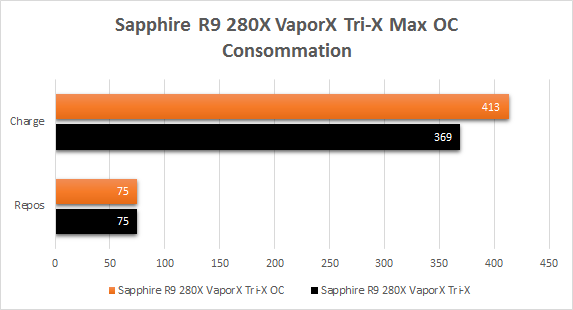
Overclocking leads to a small increase in consumption, going from 369 Watts to 413 Watts in load (I remind you that this is the total consumption of the machine at the outlet) which is still 44 Watts more! We have nothing for nothing that said and overclocking necessarily leads to this kind of overflow 😉
Temperature
Unlike some cards (such as the Powercolor R9 280X for example) Powertune does not activate I did not need to take several readings, the VRMs will certainly be very well cooled and do not need manual adjustment of the fans, let’s see it all now!
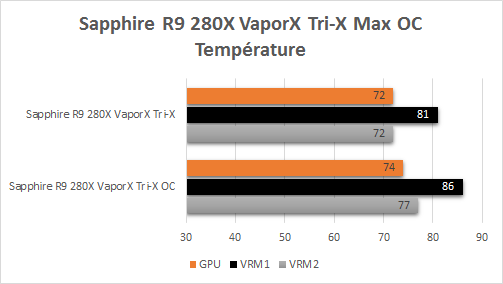
With the factory settings the temperatures are simply excellent, with a maximum of 81 ° for the hottest VRM, which is light years away from the 130 ° which can generally withstand such components. Once overclocked the card does not panic in the least with the GPU which goes from 72 ° to 74 ° and VRM1 which goes from 81 ° to 86 °, again this is really excellent (113 ° for the Powercolor R9 280X under the same conditions).
To summarize, the cooling system created by Sapphire is neither more nor more than perfectly studied, and not only at the level of the GPU as we can unfortunately see it too often.
Sound level
Warning: Part to be taken with a grain of salt, unfortunately not having access to the appropriate equipment and using an android application to take the readings The measurements below are only indicative! The readings were taken 20cm from the graphics card.
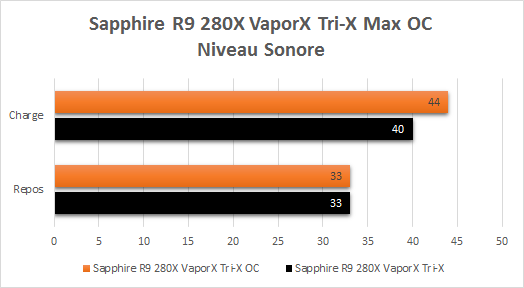
As an inevitable consequence of overclocking, noise pollution increases very logically, going from 40 dB of origin to 44 dB once the card is overclocked. It goes without saying that at 44 dB the Sapphire VaporX Tri-X is not silent but at least has the merit of cooling the components extremely well. Despite everything, I think a less aggressive fan management could have made this card even quieter while keeping temperatures at the top level, there will always be the possibility of doing it by hand with Sapphire TriXx for example.
Powertune
What will our little Powertune say with the overclocking of the Sapphire R9 280X VaporX Tri-X? Let’s see this under OCCT:

Once again the GPU does not flinch in the slightest, OCCT does not scare it and Powertune finds absolutely nothing to say, the card remains at its frequency of 1150 MHz.
Results

Overclocking does wonders on performance and we go from an average of 60.4 FPS in the games tested today to 69 FPS or a gain of about 11%, that’s not nothing!
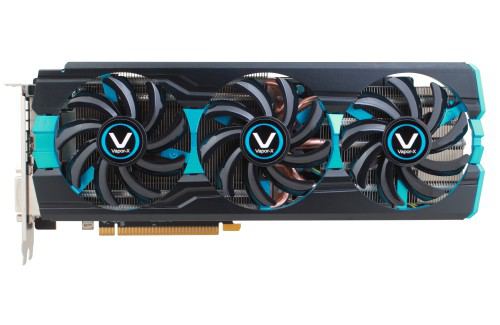
Here we are at the end of this test, what about the Sapphire R9 280X VaporX Tri-X?
First of all in terms of performance and even if the architecture is starting to date it goes without saying that the Sapphire R9 280X VaporX Tri-X still has some under the hood and will be quite capable of running all games at 1080p , to the max or a little less depending on the games and the graphics options activated. The noise pollution is very contained, at rest it will be almost inaudible (inaudible in a closed box) and in load the ventilation is slightly heard, nothing that can not be changed made a manual ventilation profile via Sapphire TriXx for example, too bad that the original ventilation is very slightly aggressive.
The build quality is clearly a strong point of today’s card, both in terms of the cooler and the care taken in cooling all the critical components (VRMs, memory, etc.), the R9 280X Vapor Tri -X is made to last.
Regarding the overclocking the card was able to take 1150 MHz for the GPU (+150 Mhz) and 1700 Mhz (+200 Mhz) for the memory, which represents a nice overclocking and a significant gain in the tests, especially knowing that the card remains extremely well cooled. On the other hand the only negative point is that it is not possible to modify the voltages, overclockers of the extreme go your way.
Offered at a price of around 220 € the Sapphire VaporX Tri-X clearly has arguments in its favor, a great look, simply excellent cooling and good performance, the only potential problem remains its length which could prevent installation in certain boxes, take a good look at the space available in your gamer config!
Advantages
- Performances
- Cooling system
- Price
- Overclocking…
Disadvantages
- … even if it is impossible to touch the tensions
- Length may be a problem
A big thank you to Yann from Text100 and AMD who allowed me to do this test.
















